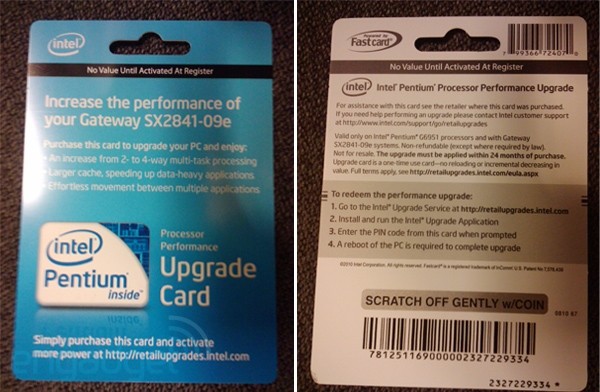Coupon for overclocking

Dear overclockers, do not be intimidated by the title: yes there will never come times when no more than 200 MHz will be issued to one person for the month of March. Nothing prevents you from accelerating your processors to transcendental heights under extreme voltages (at your own peril and risk!).
In fact, today's topic is devoted to a pilot program for absolutely legal overclocking, or rather, a software upgrade of processors using the Intel Upgrade Service and the Intel Upgrade Card (from my easy submission - “overclocking coupon”), which was held by Intel in 2011 in the USA and Canada.
The process of upgrading was subject to processors Core i3-2312M, Core i3-2102 and Pentium G622.
The procedure itself is very simple: it was necessary to purchase a card to upgrade your processor and gently scrape a protective layer with a coin to hide the code.

')
Codes were also available online. Then download a special application from the Intel Upgrade Service website , run it and enter the code.
After the reboot, the user saw in the device manager that the processor had changed the model number and enjoyed increasing the speed of his system.
The table shows the names of models and parameters before and after the upgrade:
| Up to upgrade: | After upgrade: | Advantages of the upgrade: |
| Intel Core i3-2312M 2.1GHz, 3MB L3 cache | Intel Core i3-2393M 2.5GHz, 4MB L3 cache | + 400MHz, + 1Mb L3 cache |
| Intel Core i3-2102 3.1GHz, 3MB L3 cache | Intel Core i3-2153 3.6GHz, 3MB L3 cache | + 500MHz |
| Intel Pentium G622 2.6GHz, 3MB L3 cache | Intel Pentium G693 3.2GHz, 3MB L3 cache | + 600 MHz |
Implementation
Technically, Intel Upgrade Service software did not modify the processor itself, it only made changes to the motherboard BIOS with the Intel 6 series chipset, resulting in an increase in the initially locked multiplier of the processor, and in the case of the Core i3-2312M, the L3 cache was also unlocked.
Public opinion and background
Users took this initiative from Intel extremely negatively. Foreign forums were filled with messages that Intel wants to “tear off” customers twice, and cited a variety of negative analogies. For some reason, no one remembered that in the entire history of the PC it was standard practice to produce various models of processors differing in functionality on physically identical chips. Not only Intel, but also other processor manufacturers released models in which part of the cache, the core was turned off, or frequencies were lowered.
The situation is such that developing a special design for younger models and baking it in silicon is often more expensive than “chipping” an older model. The same practice from time immemorial was used by manufacturers of graphic accelerators.
Of course, the user may be hurt that his processor does not work at full capacity, but he, in fact, paid for it significantly less. Not everyone can afford top models of processors.
It happened that there were loopholes to unlock these disabled features, and many people remember the “pencil fashion”: the contact pads on the package were connected using a simple pencil or conductive varnish. Sometimes it was even necessary to bite off one or several legs on the processor or short them with a wire loop. The thirst for free performance forced the user to turn a blind eye to the risk of disabling equipment and the unconditional loss of warranty.
Intel Upgrade Service was based on the same principles: processors with artificially limited characteristics were sold cheaper, allowed undemanding users to save, and those who needed the maximum had the opportunity to purchase an upgrade code for a relatively small amount ($ 50) and easily increase system performance.
Fantasy
Power and degree of integration in computer systems is growing wildly. Perhaps in 10 years the whole computer in its classical sense will be placed on a tiny chip (maybe the word chip itself will be out of use, and this will be some kind of three-dimensional crystal). These systems with minimal functionality will be issued as passports, and additional functions will be acquired and unlocked through the network, but these are just my fantasies.
Source: https://habr.com/ru/post/141318/
All Articles